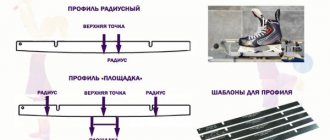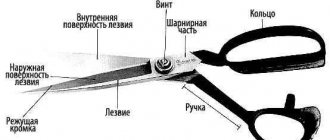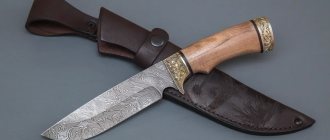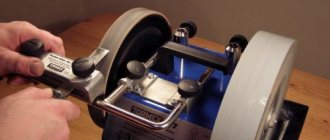Sharpening an ax at home is not difficult; the main thing is not to rush and do everything carefully. Let's determine what types of blades exist, what the sharpening angle depends on, and what you need to pay attention to when working. We will find out what sharpening methods exist and their features, how to sharpen correctly by hand and with an electric sharpener, and also identify the most common mistakes.
Types of axes Source yandex.net
Ax sharpening options
There are different types of axes. There is a construction version, and there are carpentry and lumberjack models. A classic cleaver is used to prepare firewood. When cutting meat, meat axes are used.
When engaged in hunting and tourism - options of the same name. Any blade will wear out with constant use.
In production, each ax is sharpened before delivery, and regrinding is required when the cutting edge is seriously worn.
At home, the independent process of sharpening a tool can be done in two ways:
- Electrically driven equipment;
- Manually using an abrasive wheel and sanding paper.
For proper sharpening, the following must also be taken into account:
- Density, hardness and relative humidity of wood;
- Type of processing;
- Blade steel grade;
- The degree of hardening of the working edge.
In addition to the sharpening angle, it is important to consider the width of the chamfer of the cutting surface. To work with thin wood, a wider bevel is required. And, for example, when cutting thick trees, it should be smaller in order to reduce pressure on the blade.
How to sharpen it yourself?
Sharpening an ax is the process of forming a cutting edge. It occurs at the line of connection between two chamfers cut on both sides of the blade at the same angle. In order to ensure identical chamfers, uniform and symmetrical sharpening, you will first need to make a template, which is usually cut from a piece of tin using scissors. Before starting work, the template is applied to the blade, the amount of work is assessed and the lines delimiting the sharpening area are marked with a marker. This must be done on both sides of the blade.
In addition, you need to prepare a tool that can be used:
- Electric sharpener.
- Bulgarian.
- Sandpaper.
- Abrasive block.
It is most convenient to use an electric sharpener, but in the absence of anything you have to use what you have. An experienced master can achieve good results with any device; the main factor here is the availability of appropriate skills. Before starting the process, it is recommended to study special drawings.
Ax sharpening degree
The sharpening angle for various types of work is determined in accordance with the requirements of state standard 18578-89. This standard specifies all standard ax sizes and sharpening angles.
- For heavy work, on thick wood, a larger sharpening gradient is selected.
- The average angular value for sharpening cleavers is from 35 to 45 degrees.
- For cutting medium-sized trees, an angle of 30 degrees will be sufficient.
In carpentry practice, when processing wood of small thickness, blade sharpening is used at 20 degrees or less. These parameters apply similarly to all types of axes.
Design and types of product
The design of the ax has changed little over the millennia. The design of all varieties includes the following parts:
- steel blade with a spine;
- wooden or plastic handle - ax handle;
- metal or wooden wedges or other system for attaching the blade to the handle.
The blade is made from high-quality tool alloys with a carbon content of more than 0.7%.
According to their purpose, the following types of axes are distinguished:
- Plotnitsky (universal). The main purpose is carpentry work, but with such an ax it is possible to fell a small tree and chop firewood
- Cleaver. The purpose of a heavy tool with a long handle is to chop wood in large volumes. The shape of the blade prevents it from getting stuck in the log.
- Lumberjack. Optimized for logging: tree felling and delimbing. Weighs up to 2 kg.
- Tourist. Lightweight, small-sized hatchet for universal use. Purpose: to chop dead wood, spruce branches for overnight stays, tent stakes, etc.
- Multifunctional. The butt is made in the shape of a pickaxe, hammer head, or nail puller. Used by roofers and concrete workers, amateur builders for limited volumes of various works.
Carpenter's ax Tourist ax
There are also highly specialized varieties - for cutting meat carcasses, fire engines, used in historical reconstructions, etc.
Use of electrical equipment
It is considered the simplest option. It is enough to have electrical equipment and a 220 Volt outlet.
The sharpening angle is marked using the template, then using an abrasive wheel the chamfer of the cutting surface is brought to the desired value. Safety glasses and gloves will not interfere with the work.
Let's look at the procedure for sharpening an ax for carpentry:
- Using a marker, paint over the chamfer along the entire cutting surface of the axe. This is necessary to control the progress of sharpening the tool.
- Decide in advance on the sharpening angle depending on future work.
- Turn on the sharpening equipment and smoothly grind one surface of the ax. In this case, care should be taken to ensure that no nicks remain.
- Grind the second surface of the ax in the same way. Control the resulting angle using the template.
- Clean the surface with fine-grained sandpaper.
- Polish the surface with felt, after applying a special paste.
- Apply an anti-corrosion coating to the cutting surface.
If the surface of the ax gets very hot when sharpening, you should either dip it periodically in water or use oil. Any overheating of the metal negatively affects the hardness of the material.
Recommendations for selection
According to experts, when choosing an ax for cutting meat, you should take into account some nuances
Blade Specifications
This detail is the most important in the entire design; a good blade will be thick and weighty. It is precisely these properties of the metal element that determine the classification of this device into the category of hatchets, since it is the balance between the mass and thickness of the metal that will be responsible for the chopping capabilities of the tool
As for the shape, it can be straight or rounded.
Product handle configuration
The optimal size of the handle will be the ability to operate the tool with one hand, that is, its length should be within the palm of your hand. In addition, it is best that it has a rounded shape with special recesses for a comfortable location of all fingers. This way the tool will not slip out while cutting meat.
Cutting edge type
The classic sharpening option is not suitable for an axe, since it is important that the edge remains sharp in working condition on each side. This feature will greatly facilitate the further operation and maintenance of the ax due to the fact that this type of product is the easiest to sharpen by choosing the correct sharpening angle
The optimal angle would be 40 degrees. This product will allow the tool to cut fibers and bones as deeply as possible.
Type of steel used
As a rule, certified products, unlike products made by handicraft, will have a special mark on the head of the tool. Such an abbreviation will contain data about the grade of steel used to produce the ax.
It is important to pay attention to the fact that it should be in the area where the handle comes into contact with the cutting part
Additional configuration details
Good and high-quality products should have a special eyelet on the body, which will allow you to properly store the equipment after use.
Place of purchase and cost
Often the cost of the same product will differ significantly when comparing the pricing policies of supermarkets and markets. Therefore, you can safely purchase kitchen tools at retail outlets, which will save money, however, this will not in any way affect the quality of the purchased product. Also, for rare use of an ax, buying an expensive tool is simply pointless. Today, inventory from domestic and foreign brands is on sale, which, for the most part, have high quality indicators for the products sold.
Ease of use
It is best to select kitchen or professional tools yourself. Before purchasing, you should definitely test the cleaver, hold it in your hands, evaluate the comfort of the handle, weight and other characteristics of the product you like. Otherwise, there is a risk that even a high-quality and attractive tool will simply be unsuitable for a cook, butcher or housewife.
Sharpening an ax by hand
If you don't have a power tool, you can sharpen the ax by hand. To do this, the following will be useful: a wide file, metal sandpaper, a sharpening stone, felt material, polishing paste, gloves and glasses.
The sharpening process is carried out in the following order:
- Use a wide file to process the cutting surface of the ax on both sides. Clean off all unnecessary irregularities.
- Remove burrs with metal sandpaper, making turning movements with the ax on one side and the other.
- Polish the sharpened surface and coat it with anti-corrosion material.
Sharpening by hand is difficult to do because you have to carefully work with the whetstone while holding the ax. Because of this, this option seems labor-intensive.
Characteristics
The functions of a kitchen meat hatchet are inherent in the very name of the tool. The product does not cut, but rather chops without destroying the connective fibers of the fabric - this is facilitated by the width of the blade and increased weight. The balanced shape and minimal thickness of the metal prevent bones from crumbling and cracks from forming. In operation, such axes are much more ergonomic than knives, which can also be used to chop meat, with some effort. The efficiency of the product is high, and the user’s hand does not get tired.
Material
To create a butcher's hatchet, metal is used that is resistant to corrosion and scratches. Companies often produce tools from alloy steel grades X12MF, AUS-8, VG-10, which are best suited for this purpose. The advantage of this material is its long service life. If nicks and scratches appear on the blade, it becomes more difficult to work with - in this case, immediate grinding and sharpening is required.
Blade size and shape
A meat cleaver can have different shapes, so the choice of the right type will depend on the purpose of use. To work without extra effort, you should give preference to a product with a very wide blade and a slightly convex shape of the cutting side. This will make the process of splitting bones much easier. The described shape allows the ax to penetrate the meat at an acute angle. The blade is usually made elongated so that a larger area of the carcass is captured. The optimal blade size in a kitchen hatchet for chopping meat is considered to be 135-180 mm.
Sharpening
The sharpening angle of the tool is of great importance. It is desirable that it be within 25-30 degrees. The sharpening should not be an even cone, but rather have a slightly rounded shape, with a slight acute angle. This will make it easier for the metal to penetrate the product - even with a slightly dull blade, the bones will break without problems and the meat will be cut quickly.
You can make the blade sharp yourself. One of the important aspects of such work is a correctly formed chamfer. The process is carried out in several stages. The best material for this purpose is a ceramic musat (has some similarities with a file), which is a rod with a handle with an oval or round cross-section. For sharpening, you can use a diamond stone or a sharpening wheel.
Common Mistakes
- Sharpening an ax using an angle grinder. When sharpening with an angle grinder, the surface of the ax becomes very hot. In addition, due to the high rotation speed, the sharpening surface does not turn out smooth.
- Overheating of the working surface. An excessive increase in the temperature of the metal leads to a change in its structure. It becomes coarse-grained and its impact strength decreases.
- Wear of sharpening tools. It is recommended to periodically change sharpening discs and abrasive stones.
In most cases, there is no point in completely demolishing the “native” factory sharpening. It is necessary to monitor the cutting surface, by which you can determine in advance whether the tool is dull or not.
With proper care, only a small sharpening of the edge of the ax will be enough. The current tool consists of high quality steel grades, without the need for constant regrinding.
There are rare moments when an ax hits nails or other metal parts. In this case, it is enough to use a regular abrasive stone.
Precautions during operation
Sharpening an ax is dangerous in many ways, and therefore requires compliance with safety precautions:
- Always wear hearing and eye protection.
- When using tools, make sure you know how to use them and read all safety instructions that come with the tool.
- Make sure you are not wearing loose clothing. Wear a long-sleeve shirt, pants and shoes.
- Wear gloves when filing an ax by hand.
- After sharpening, be careful when running your finger along the blade.











